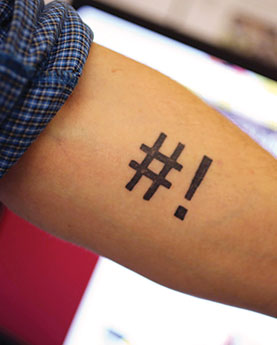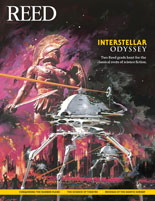
IRIS login | Reed College home Volume 94, No. 1: March 2015
Eliot Circular
Software Studio Says “Hello, World!”

Interpreting the prime directive, Reed flexes its codeslinging muscle at the SDS. Photo by Leah Nash.
Codeslingers, limber up your fingers. In January, thanks to financial support from alumni and friends, Reed launched a Software Design Studio (SDS) to help students explore the art and craft of coding through hands-on instruction and thoughtful mentorship.
Many Reed students already know how to write code as part of their coursework in physics, math, or psychology, but the SDS is designed to bolster programming skills with practical experience directed by a technologist in residence. It is also aimed at students majoring in disciplines such as classics or music who have never written a line of code but are intrigued by the intellectual challenge.
“Reedies are extraordinarily good at problem solving,” says Marty Ringle, chief information officer. “What we hope to provide through the SDS is expert mentorship that will enable any student—not just math and science majors—to solve deep computational problems. This is about bending technology to your will.”
Reed’s first technologist-in-residence is Lennon Day-Reynolds ’03, director of engineering at Urban Airship. Lennon previously worked at Twitter, Sun, and Dark Horse Comics.
Students at the SDS will work on an array of fascinating projects. Some may arise from their studies, such as the classics major who wants to analyze anaphora in the Iliad. Some may benefit the community, such as “what-if?” scheduling software for students. And some may simply appeal to Reedies on an intellectual level, such as designing a program to play the ancient game of Go.
The SDS draws on the college’s proud tradition of integrating technology into the liberal arts. In the ’50s, Prof. John Hancock [chemistry 1955–89] built the DIMWIT system for molecular analysis, using relays from confiscated pinball machines. In the ’80s, Reed’s pioneering D-Lab produced a host of applications for higher ed, including RaSCAL, a real-time Pascal compiler, and the first color graphics system for the Macintosh. In the ’90s, students and professors at the Center for Advanced Computation proved that the 24th Fermat number, a numeric behemoth consisting of five million digits, was not prime. In 2013, Hannah Kosstrin, then visiting professor of dance, developed the iPad app KineScribe, which allows dancers to use the Labanotation system of choreography notation. (Not to mention that guy Steve Jobs . . .)
The SDS operates on an intern model. Reed students who are selected for the program are paid on an hourly basis. SDS interns are paired with mentors who provide guidance and offer insight into internships, networking, and job hunting.
The project has attracted overwhelming student interest (120 applications for 10 spots) from a multitude of academic disciplines, but is still shy of its fundraising goal. To find out how you can help, send email to Duncan Rotch.

LATEST COMMENTS
steve-jobs-1976 I knew Steve Jobs when he was on the second floor of Quincy. (Fall...
Utnapishtim - 2 weeks ago
Prof. Mason Drukman [political science 1964–70] This is gold, pure gold. God bless, Prof. Drukman.
puredog - 1 month ago
virginia-davis-1965 Such a good friend & compatriot in the day of Satyricon...
czarchasm - 4 months ago
John Peara Baba 1990 John died of a broken heart from losing his mom and then his...
kodachrome - 7 months ago
Carol Sawyer 1962 Who wrote this obit? I'm writing something about Carol Sawyer...
MsLaurie Pepper - 8 months ago
William W. Wissman MAT 1969 ...and THREE sisters. Sabra, the oldest, Mary, the middle, and...
riclf - 10 months ago